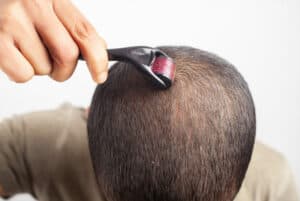As a hair transplant surgeon, I have witnessed the tremendous advancements in hair restoration techniques over the years. Among these advancements, stem cell technology has emerged as a promising approach to combat hair loss and promote natural hair regrowth. Stem cell hair transplants and stem cell hair treatments are two distinct procedures that utilise the power of stem cells for hair restoration. In this article, we will explore the key differences between these two approaches, backed by research papers in the field.
What are Stem Cells?
Stem cells are unique cells in the human body that have the remarkable ability to develop into different cell types and repair or regenerate damaged tissues. They are characterised by their ability to self-renew, meaning they can divide and produce more stem cells, as well as differentiate into specialised cell types with specific functions.
Stem Cell Hair Transplants
Stem cell hair transplants, also known as stem cell hair restoration, involve extracting stem cells for the purpose of creating new hair follicles under lab conditions and then implanting them into the patient’s areas of hair loss using the same techniques as a non-stem cell hair transplant, the FUE hair transplant method. This procedure is based on the principle of regenerative medicine, utilising the regenerative capacity of stem cells to restore and regenerate hair follicles.
Research studies have shown that hair follicles contain a niche of adult stem cells, known as dermal papilla cells, which play a crucial role in hair growth and regeneration. These stem cells have the potential to differentiate into various cell types, including hair follicle cells, and can stimulate dormant hair follicles to resume active hair growth.
One research paper published in the Journal of Dermatological Science in 2017 by Ohyama et al., titled “Dermal papilla cell-derived hair follicle regeneration using stem cell technology,” explored the potential of dermal papilla cells in hair regeneration. The study demonstrated that the transplantation of stem cell-enriched dermal papilla cells resulted in robust hair regrowth in mice, offering a promising approach for hair restoration in humans.
Stem Cell Hair Treatments
On the other hand, stem cell hair treatments, also known as stem cell therapy or stem cell-based hair loss treatments, do not involve surgical transplantation. Instead, these treatments utilise stem cell-derived products, such as growth factors and cytokines, to stimulate hair growth and improve hair density.
A research paper published in the Journal of Cosmetic Dermatology in 2018 by Choi et al., titled “Effect of adipose-derived stem cell-conditioned medium on the proliferation and migration of human hair follicle dermal papilla cells,” investigated the effects of stem cell-conditioned medium on the proliferation and migration of dermal papilla cells. The study revealed that the conditioned medium from adipose-derived stem cells significantly increased the proliferation and migration of dermal papilla cells, indicating its potential as a hair growth-promoting treatment.
Stem cell hair treatments can take various forms, including topical applications, injections, or the use of specialised devices that deliver stem cell-derived products directly to the scalp. These treatments aim to provide a nourishing and stimulating environment for existing hair follicles, promoting their growth and preventing further hair loss.
Are there any alternative options to stem cell hair transplants?
Yes, there are alternative options to stem cell hair transplants for individuals seeking hair restoration. While stem cell hair transplants are a cutting-edge approach in principle, there are other techniques available that can address hair loss concerns. Here are a few alternative options:
- Traditional Hair Transplantation: Traditional hair transplantation techniques, such as Follicular Unit Transplantation (FUT) or Follicular Unit Extraction (FUE), have been widely used for many years. These procedures involve transplanting healthy hair follicles from the donor area (typically the back of the scalp) to the recipient area experiencing hair loss. Unlike stem cell hair transplants, these techniques do not involve the use of stem cells but can provide natural-looking results.
- Platelet-Rich Plasma (PRP) Therapy: PRP therapy involves extracting a sample of the patient’s own blood, processing it to concentrate platelets, and then injecting the platelet-rich plasma into the scalp. Platelets contain growth factors that can stimulate hair follicles, promote hair growth, and improve hair thickness. PRP therapy is a non-surgical alternative that can be used alone or in combination with other hair restoration techniques.
- Laser Therapy: Low-level laser therapy (LLLT) is a non-invasive treatment option that uses red or near-infrared light to stimulate hair follicles and promote hair growth. This treatment can be administered via handheld devices or in-office treatments. While the exact mechanisms of action are not fully understood, LLLT is thought to improve circulation and stimulate cellular activity in the scalp.
- Medications: Topical medications, such as minoxidil and oral medications such as finasteride, are FDA-approved treatments for hair loss. Minoxidil is applied directly to the scalp and can help promote hair growth and slow down hair loss. Finasteride is an oral medication that can be prescribed for men to help prevent further hair loss. These medications work by influencing hormone levels or improving blood flow to the hair follicles.
It’s important to note that the effectiveness of these alternative options may vary from person to person, and consultation with a qualified hair restoration surgeon is recommended to determine the most suitable approach based on individual needs and goals. They can assess your specific hair loss condition, discuss the pros and cons of different treatments, and provide personalised recommendations.
How much does a stem cell hair transplant cost?
The cost is still undetermined as at the time of writing this article, stem cell hair transplants aren’t available in the UK market. The technology is still in it’s infancy and it will take some time in order to bring it into commercial use. However just like with any new technology that comes out, expect the cost to be much higher than a traditional hair transplant until (and if) it reaches mass adoption where the pricing will then be more affordable.
What are the side effects of a stem cell hair transplant?
Whilst the procedure is not available yet, here are some of the possible side effects:
- Pain and Discomfort: After a stem cell hair transplant, some individuals may experience mild to moderate pain or discomfort in the donor and recipient areas. This can be managed with pain medications prescribed by the surgeon and typically subsides within a few days.
- Swelling: Swelling in the scalp, particularly in the recipient area, is a common side effect after a hair transplant procedure. It is usually temporary and resolves within a few days or weeks. Elevating the head while sleeping and applying cold compresses can help alleviate swelling.
- Itching and Tingling: As the scalp heals, some individuals may experience itching and tingling sensations. It is important to avoid scratching or rubbing the scalp to prevent any damage to the newly transplanted hair follicles.
- Infection: Although rare, there is a risk of infection at the surgical sites. Proper post-operative care, including keeping the scalp clean and following the surgeon’s instructions, can minimise the chances of infection. If any signs of infection, such as increased redness, swelling, or pus, occur, it is important to consult with the surgeon promptly.
- Bleeding: During the procedure, there may be minor bleeding from the donor and recipient areas. This is typically controlled during the surgery. However, in some cases, post-operative bleeding may occur. Applying gentle pressure and contacting the surgeon if bleeding persists can help manage this side effect.
- Scarring: Stem cell hair transplants will potentially result in minimal scarring, as advanced techniques, such as Follicular Unit Extraction (FUE), are used. However, in rare instances, hypertrophic scars or keloids can occur, particularly in individuals prone to excessive scarring. Discussing the potential for scarring with the surgeon before the procedure can help manage expectations.
It is important to note that these side effects are typically temporary and subside over time. Choosing a skilled and experienced hair transplant surgeon and following their post-operative instructions can help minimise the risk of complications and ensure a successful outcome. If any concerns or unexpected side effects arise, it is always recommended to consult with the surgeon for proper evaluation and guidance.
Key Differences
The main difference between stem cell hair transplants and stem cell hair treatments lies in the nature of the procedure. Stem cell hair transplants involve the surgical transplantation of hair follicles enriched with stem cells, while stem cell hair treatments utilise stem cell-derived products to stimulate hair growth without surgical intervention.
Stem cell hair transplants are typically recommended for individuals with significant hair loss or baldness, where the transplantation of new hair follicles is necessary to restore a natural-looking hairline. This procedure requires expertise in hair transplantation techniques and may involve a longer recovery period compared to non-surgical treatments.
On the other hand, stem cell hair treatments are often considered as an alternative or complementary option for individuals in the early stages of hair loss or those seeking to improve the overall health and density of their existing hair. These treatments can be performed on an outpatient basis and typically have minimal downtime.
Conclusion
Stem cell technology has opened up new avenues for hair restoration and regrowth. Stem cell hair transplants and stem cell hair treatments offer different approaches to address hair loss concerns. Stem cell hair transplants involve surgical transplantation of hair follicles enriched with stem cells, while stem cell hair treatments utilise stem cell-derived products to stimulate hair growth non-surgically.
Both procedures have shown promising results in research studies, highlighting the potential of stem cells in hair regeneration and restoration. The choice between a stem cell hair transplant and a stem cell hair treatment depends on individual factors, such as the extent of hair loss, patient preferences, and the recommendation of a qualified hair restoration surgeon.
It is crucial to consult with a knowledgeable and experienced hair transplant surgeon to determine the most suitable treatment approach based on individual needs and goals. With the ongoing advancements in stem cell research and technology, the future of hair restoration looks brighter than ever before.
References:
- Ohyama, M., & Veraitch, O. (2017). Dermal papilla cell-derived hair follicle regeneration using stem cell technology. Journal of Dermatological Science, 88(1), 10-16.
- Choi, J. S., et al. (2018). Effect of adipose-derived stem cell-conditioned medium on the proliferation and migration of human hair follicle dermal papilla cells. Journal of Cosmetic Dermatology, 17(1), 15-23.
- https://www.ncbi.nlm.nih.gov/pmc/articles/PMC6098866/
- https://www.ncbi.nlm.nih.gov/pmc/articles/PMC4066645/








